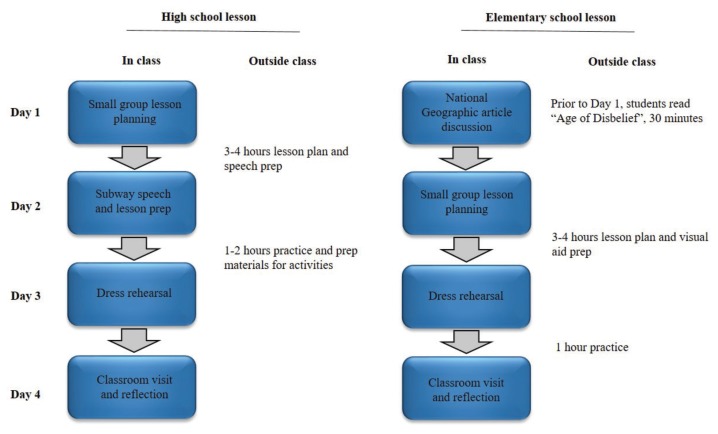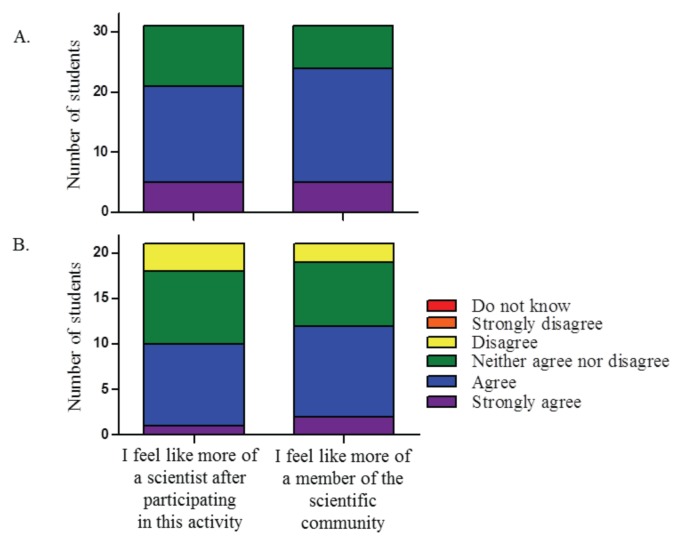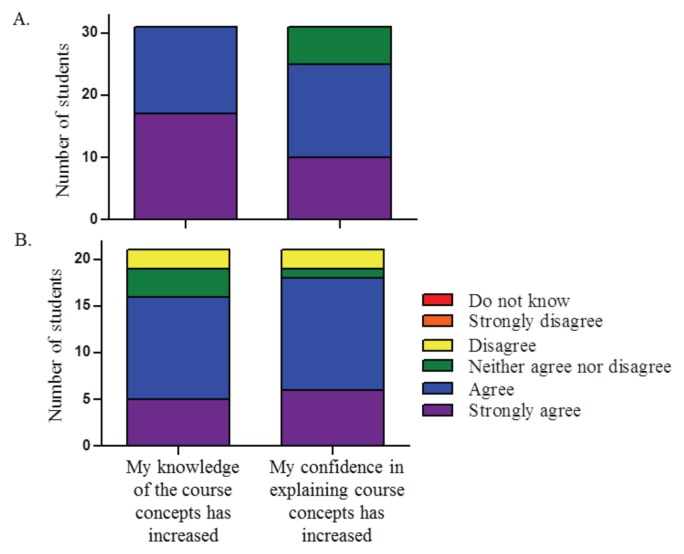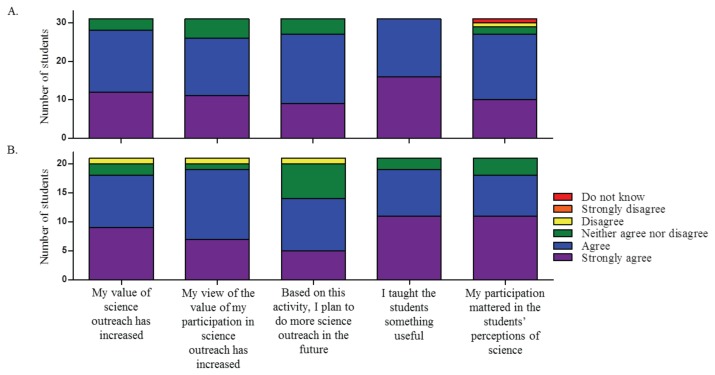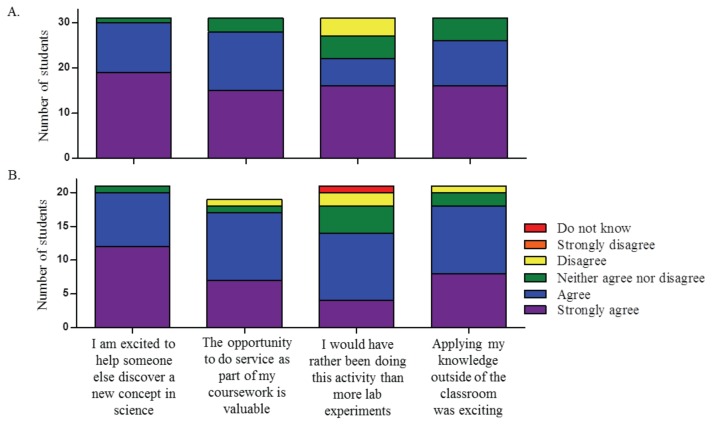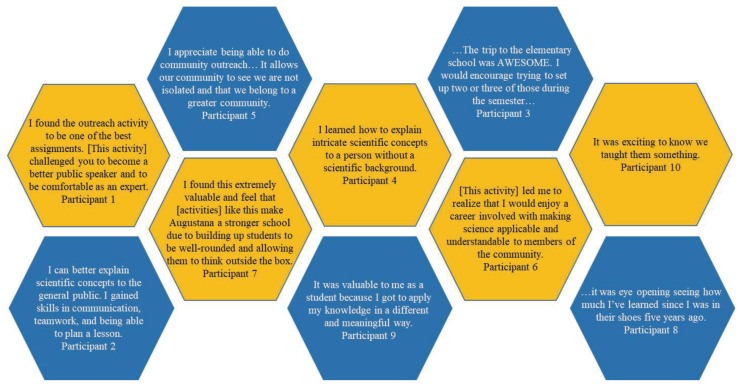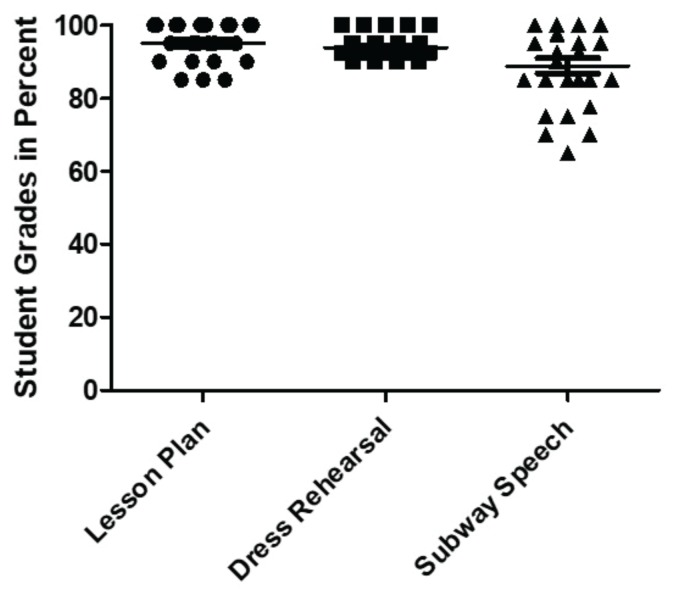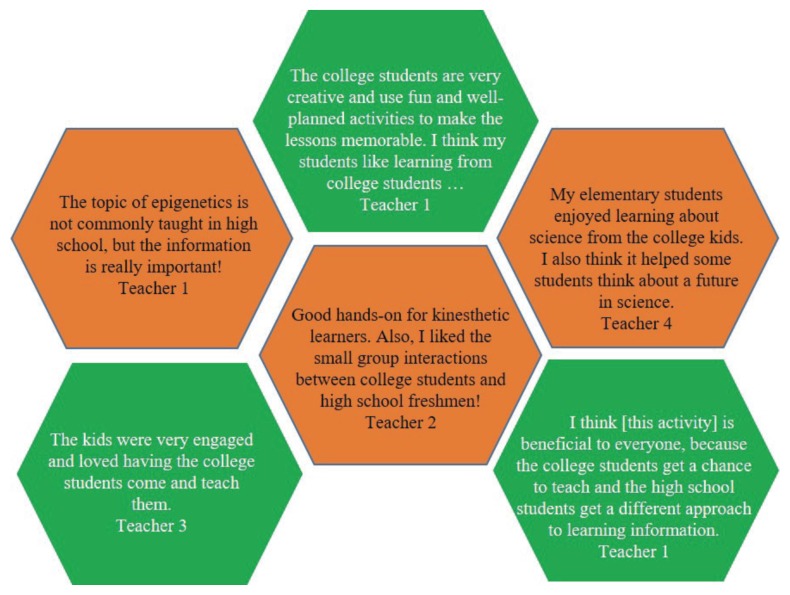Abstract
Success and persistence in the life sciences is influenced by a student’s self-efficacy, sense of belonging, and science identity. It has already been demonstrated that outreach experiences and service learning by graduate students in K–12 schools aid in the graduate students’ confidence and intrinsic satisfaction. Others have shown the importance of engaging scientists in outreach activities, both for the benefit of the K–12 student and as a way to engage scientists with the community. We predicted it would also be beneficial for undergraduates to engage in service-learning activities during their coursework because working with K–12 students would solidify their scientific identity and sense of belonging while deepening their understanding of the course content. Consequently, we implemented service projects in our upper-level molecular biology and human physiology courses at a primarily undergraduate institution that focuses on five core values: Christian, Liberal Arts, Excellence, Community, and Service. Outcomes such as the undergraduate students’ value of service, confidence in their knowledge of course content, ability to create effective lesson plans, and science identity were measured using anonymous surveys. Overall, students reported that they highly valued and enjoyed this unique experience. This type of activity could be used to increase future scientists’ awareness of synergistic activities such as academic service and of the joy found in such activities. Future plans include measuring the effects on the participating high school and elementary school students and visiting schools with a high proportion of students from underserved populations.
INTRODUCTION
Training the next generation of scientists to value the importance of communicating science to the general public is essential for opening the door to discussions between nonscientists and scientists. Building bridges between communities and scientists can help to foster a sense of respect and trust on both sides. Today, many scientists (42%) do not get involved in scientific service-learning activities, despite the documented benefits for all groups involved—K–12 students, K–12 teachers, and scientists themselves (1). Some of the main reasons include a lack of time, inadequate knowledge about sources of outreach opportunities, and a lack of confidence in their communication skills to the general public (2). Therefore, training scientists to effectively communicate with the general public is a necessity, especially in light of the current tension between science and the general public (3). We predict that exposing scientists early in their career to service-learning experiences that involve educational outreach will help them feel comfortable pursuing these activities in the future.
In addition to preparing a generation of scientists who value communication between the scientific community and the general public, these experiences advance the goals of Vision and Change, a document published by the American Association for the Advancement of Science in 2009 (4). This document outlined six core competencies that undergraduate biology students should master. The service-learning experiences examined in this paper help to achieve parts of two of these competencies: ability to integrate science and society, and ability to communicate and collaborate with other disciplines. Specifically, explaining scientific concepts to diverse audiences through team participation is an example of the “ability to communicate and collaborate” competency (4). Therefore, service-learning activities can be an excellent way to address these competencies because students find for themselves the relevance of the subject matter to society.
The ability to communicate science to diverse audiences also enhances a student’s science identity. The definition of science identity is feeling that one is an authority on a scientific topic and thus able to refer to oneself as a scientist. Undergraduate students who identify as scientists persist longer in STEM fields because they have enhanced confidence in their abilities (5). Therefore, finding ways to encourage students to think of themselves as scientists is valuable to retaining students in STEM fields (6). Although service-learning activities have been performed in labs in many disciplines, such as neuroscience (7), specifically measuring science identity and students’ willingness to pursue additional educational outreach in the future has not been performed. To that end, we hypothesized that exposing young scientists (undergraduates) to service-learning experiences at an even earlier point in their education would benefit their identity as scientists, would encourage them to participate in service-learning activities later on in life, and would allow them to understand course content at a deeper level. We surveyed our students after such an experience to test our hypothesis.
Intended audience
This activity is intended for natural science majors and could be implemented at any level of a four-year curriculum. We implemented the activity in two upper-level biology courses: Molecular Biology and Human Physiology. It could also be modified for use in a college nonmajors biology or chemistry course or in a high school science course.
Learning time
Our activity took place over either three or four 3-hour laboratory periods, for a total of 9 to 12 hours of in-class time. The number of periods depended on whether students were preparing presentations for elementary school or high school students. Students preparing elementary-school lesson plans also required time for discussion during one lecture period before the lab periods. All students worked outside of class for approximately four hours to develop their lesson plans. A workflow for both types of presentations is depicted in Figure 1.
FIGURE 1.
Timeline of lesson plan preparation. Preparation took 4 class meetings for both the Molecular Biology course (left) and Human Physiology course (right). Some time is required outside of class for further development of the lesson.
Prerequisite student knowledge
Students do not need any specific prerequisite knowledge, and the activity itself can be used to cover specific content that is not covered elsewhere in the course. It was expected that students would learn the content as they developed their lesson plan.
Learning objectives
Upon completion of this activity, students will:
recognize an increase in confidence with the subject, sense of belonging, and science identity within themselves;
value service-learning as an important aspect of a scientist’s training;
rank service-learning activities as important for their future careers as scientists; and
develop meaningful lesson plans geared toward nonscience audiences.
PROCEDURE
Materials
Materials varied depending upon what content was being covered. In the Molecular Biology course, students were provided with a budget of $60 for materials. Some examples of materials used in the lesson plans created by these students include rubber tubing, sticky notes, colored tape, markers, and cardboard boxes. In the Human Physiology course, student instructors were provided with the necessary equipment to conduct a basic sensory laboratory, including metal probes, yardsticks, tuning forks, reflex hammers, eye charts, lamps, and colored paper. Also provided were poster board and markers for creating visual aids. Students were given a small budget ($20/group) to buy other needed materials. Students in both classes chose to use some of their budget to buy candy (with the permission of the elementary or high school teacher) as rewards for the K–12 students.
Contacting K–12 teachers began before the start of the semester to allow time for logistics to be determined. We began with University alumni who are in-service teachers, but all teachers contacted were generally enthused about a classroom visit. Teachers were asked for information about their classes and classrooms, such as number of students, classroom layout, permission to take photos during the activity, and if there was a specific topic they wanted the college students to cover. After the lesson, teachers were surveyed about the experience of their students in order to determine how effectively the fourth learning outcome was achieved.
Student and faculty instructions
The activity in both courses began by allowing the students to explore the value of communicating science to the general public and the urgent need to continually engage the public in scientific discussions. This was done using subway speeches or a discussion of a required reading (see details below).
As each course had its own laboratory schedule and instructor emphasis, the student and faculty instructions for implementation in the two courses differed slightly, and we will elaborate on each separately.
Elementary school lesson plans (Human Physiology course)
In the Human Physiology course, which presented at the elementary school, the activity began with a discussion in lecture (about 25 minutes). Actual work on the service-learning project followed over the course of two lab periods during the semester. The third lab period was the day the students presented their lessons at the elementary school. Only about half of the lab time during the first lab period was required for the activity. This lab had two sections, with 15 to 16 students in each section. Students were divided into lab groups of 4 to 5 that were consistent throughout the entire semester.
Student and faculty instructions for creating elementary-school lesson plans were as follows (see also Fig. 1):
Article discussion. We required the students to read a National Geographic article titled “The Age of Disbelief” (8) as a way to stimulate discussion on the public’s perception of science. Students wrote a one-paragraph reaction piece to the article that was worth 5 points. The instructor led a discussion of the article by asking students to volunteer to read their reaction pieces out loud or to give a summary. Other questions such as, “What are things scientists could do to help people increase their trust and understanding of science?” and, “At what age do you think people begin to be skeptical about science?” were asked of the group. To end the discussion, the instructor suggested that one small way to provide the public with a positive experience with science would be to explain physiological concepts to elementary students. The instructor then introduced the activity.
Lesson design. During the first lab period, each lab group choose a topic in sensory physiology to demonstrate to the elementary students. Sensory physiology was chosen because it was not covered in regular lab or lecture activities, lends itself nicely to hands-on activities, is easily relatable to children, and provides an opportunity to perform guided experiments to answer questions about how the body works. The topics within sensory physiology included vision, olfactory and taste, hearing and balance, touch, and reflexes. Students were informed that the elementary students would be divided into groups of 5 to 6, and then for about 50 minutes they would rotate through the four different sensory stations (12 minutes each) that the undergraduates had prepared. Each undergraduate group planned their 12-minute activity using a handout (Appendix 1) that guided them through the process of designing a lesson to fit this format: 2–3 minute introduction with visual aids, 5–7 minutes of hands-on activity, and 2–3 minutes of assessment. Groups reviewed their handout with their instructor before handing it in for a grade (an example can be found in Appendix 3). This activity took about 1.5 hours of the 3-hour lab period.
Dress rehearsal. The entire second lab period (3 hours) was devoted to “dress rehearsals” of the activities that students proposed. No specific instructions were given to the groups in between the planning period and the dress rehearsal; instructors simply answered questions, facilitated the purchase of supplies, and reminded the students to prepare for the dress rehearsal. Each group arrived to class with their materials in hand, and presented their activity to other members of the class who posed as elementary-aged students. A rubric (Appendix 2) was used by the instructor to evaluate the timing, content, and effectiveness of each presentation. This presentation was worth 20 points, the highest point allocation of the experience. Students were to make the changes that the instructors suggested in order to receive full points for the actual presentation to the elementary school students, which was worth 10 points.
Presentation day. On the day of the visit to the elementary school, the class travelled to the school with their materials in hand. Carpooling was arranged by the instructor. The undergraduates introduced themselves, explained the instructions to the elementary students, guided the elementary students through the stations, and provided a wrap-up of the lessons. After the experience, the undergraduates travelled back to the classroom for a debriefing session. Groups compiled the assessment data from their individual activity into a brief report that also included aspects of their presentation that went well and aspects that could be improved. Students then verbally reported to the class and submitted a written report to the instructor. This part of the activity required the entire lab period. More-detailed faculty instructions can be found in Appendix 12.
High school lesson plan (Molecular Biology course)
The Molecular Biology course consisted of three different lab sections of 10 to 12 students each. The timeline consisted of four separate 3-hour meetings over four weeks, but this could be condensed or expanded, depending upon the frequency and duration of the class meeting (Fig. 1). The entire class period was used for each of the class meetings. The subway speeches (see below) may not take an entire 3-hour class period, depending on the number of students in the course.
Student and faculty instructions for creating high school lesson plans were as follows:
Lesson design. Within each lab section, students were divided into small groups of 3 to 4 students. Each small group was tasked with developing a lesson plan about epigenetics, a topic that was chosen by the high school teachers. The lesson plan designed by students was required to include student learning outcomes, required and suggested resources, engagement, exploration, explanation, elaboration, and evaluation activities (Appendix 4). Groups were graded on their lesson plan according to a common rubric that included accuracy of content, pertinence to epigenetics, and inclusion of required components (Appendix 5). Groups uploaded their lesson plan to the course website, where all students in the class voted on their favorite lesson plan. The favorite lesson plan was then used and developed by all three lab sections, but with slight variations in delivery according to the lab section. Each lab section presented to one high school class, so the same lesson was presented to three different high school classes. This strategy allowed each high school class to experience similar activities and content.
Subway speech. In preparation for the second week, individual students chose a primary article from the scientific literature that was related to epigenetics (student instructions found in Appendix 6). Students deposited their chosen articles into an online forum so the instructor could ensure each article was appropriate for the lesson. At the second lab meeting, each student presented a 5-minute speech, called a “subway speech,” to the rest of the lab section. In these speeches, students summarized the article as if they were talking to the general public. Students filled out evaluation forms for their classmates’ speeches (Appendix 7). Using a common rubric, each student was graded by the instructor (Appendix 8). After the subway speeches, time was given for the whole lab section to prepare the selected lesson. Students in their small groups took ownership of a specific part of the lesson, for example, the opening game, a skit, or the final assessment. During this time, students created the props and hammered out the details of their part of the lesson.
Dress rehearsal. During the dress rehearsal, each lab section presented the selected lesson, with each small group presenting their part of the lesson. The dress rehearsal allowed students to formulate exact wording, timing, and actions during the lesson. Feedback was largely student-driven.
Presentation day. During week four, each lab section visited one high school biology class. Undergraduate students took control of the classrooms and executed their activities without much input from the instructor. In addition to making their whole-class presentations, undergraduate students interacted with the high school students one-on-one. Upon return to the University, there was a debriefing session: Using a handout provided by the instructor, the students answered questions about the positives and negatives of the lesson, and how they might change the lesson if they were to teach it again. Students also graded themselves and their peers using the handout (Appendix 9). More-detailed faculty instructions are provided in Appendix 13.
Suggestions for determining student learning
After the debriefing session for each course, the instructors left the room and students were given a quantitative measures survey via a Likert scale (Appendix 10) to assess the research questions of this study. Exemption was granted by the Augustana University Institutional Review Board. The survey was administered by faculty not involved in the course or this study to avoid conflict of interest and to reduce biased student feedback. Teachers in the K–12 classrooms were sent surveys via e-mail to assess the ability of the undergraduate students to develop successful lesson plans.
Sample data
An example high school lesson plan submitted by a group in the Molecular Biology course can be found in Appendix 11.
DISCUSSION
Direct communication between scientists and the general public is needed to promote trust and respect. The public needs to inform scientists about how to improve the lives of the community, and scientists need to share their methods and discoveries to communities in a meaningful and accessible way. By incorporating service-learning activities into the undergraduate classroom, we are providing students with scientific content while at the same time giving them valuable skills beyond content knowledge. For example, the activity fulfills one of the competencies of Vision and Change, which is the ability to explain science to diverse audiences (4). In addition to meeting national standards for biology education, this activity also realizes our own institution’s ideals, which are summarized in our five core values: Christian, Liberal Arts, Excellence, Community, and Service.
Field testing
The students in these courses were a majority Caucasian with an average GPA of 3.6. Five students were first-generation college students, and there were 23 males and 29 females in the study. The Molecular Biology course had a total of 31 students, while the Human Physiology course had a total of 21 students participating. This activity has been implemented three times in each course, with the survey administered during the second iteration of the activity.
Evidence of student learning
Twenty-two out of 31 students in the Molecular Biology course (MB students), who presented to high school classes, agreed or strongly agreed that the activity increased their scientific identity, as measured by the survey question “I feel like more of a scientist after participating in this activity” (Fig. 2A). Ten out of 21 students in the Human Physiology course (HP students), who presented to the elementary class, agreed or strongly agreed that they felt more like scientists after participating in the activity (Fig. 2B). Twelve HP students reported that they felt more like a member of the scientific community. Over two-thirds of the students in both courses reported an increased in their knowledge of the subject matter and confidence in explaining concepts (Fig. 3). Figures 2 and 3 both address learning outcome 1: students reported feeling comfortable with the material they taught, having a sense of belonging, and seeing themselves as scientists. These three gains have been shown by many to be important for student learning, with science identity being key (9). The majority of the students in both courses reported that they placed greater value on science service-learning and were more apt to participate in science service-learning in the future (Fig. 4), which addresses learning outcome 3. (Note that students verbally indicated that they were confused about the prompt, “Based on this activity, I plan to do more science outreach in the future” because they had already planned on doing science outreach in the future, which could explain the why fewer HP students agreed or strongly agreed with the statement.)
FIGURE 2.
Students’ scientific identity. Students’ feelings about being a scientist were assessed using indirect quantitative measurements. A. Outcomes for Molecular Biology students—high school lesson plan. B. Outcomes for Human Physiology students—elementary school lesson plan.
FIGURE 3.
Students’ efficacy in the material. Students’ feelings about how much they learned the course content after completing the activity were assessed using indirect quantitative measurements. A. Outcomes for Molecular Biology students—high school lesson plan. B. Outcomes for Human Physiology students—elementary school lesson plan.
FIGURE 4.
Students’ value of service. Students’ feelings about service and service-learning after completing the activity were assessed using indirect quantitative measurements. A. Outcomes of Molecular Biology students—high school lesson plan. B. Outcomes of Human Physiology students—elementary school lesson plan.
Although two different lesson plans were used in this study, the results were similar. The biggest difference between the MB students and the HP students was seen in their answers to the prompts about science identity. MB students had a slightly higher science identity compared to the HP group (Fig. 2A). This may be because the MB students taught a group of students that they see as their peers (high school students as compared to elementary school students), or it may be because the content that they taught was at a more advanced level. Despite this small difference, the activity was a valuable teaching tool for both groups (Fig. 3).
Students highly valued the opportunity to do service-learning as outreach to the community as a part of their coursework (Fig. 5), which directly addressed learning outcome 2. Figure 5 shows that students generally enjoyed the opportunity. Although 68% of students would have rather done the service-learning activity in lieu of more laboratory experiments, several students mentioned after taking the survey that they felt that both this activity and lab experiments were equally valuable. Although most of the students have firm career plans by their junior or senior year, at least one student mentioned that the activity had prompted them to consider a career in K–12 education.
FIGURE 5.
Students’ enthusiasm toward the service-learning activity. Students’ feelings about how much they enjoyed the service-learning activity were assessed using indirect quantitative measurements. A. Outcomes of Molecular Biology students—high school lesson plan. B. Outcomes of Human Physiology students—elementary school lesson plan.
Comments from students were 100% positive (Fig. 6). Not only did students value teaching information to others, but they reported that they understood the content better themselves. One student wrote, “It was valuable to me as a student because I got to apply my knowledge in a different and meaningful way.” Students also reported learning how to speak about science to the general public: “I learned how to explain intricate scientific concepts to a person without a scientific background.”
FIGURE 6.
Students’ written comments following the service-learning activity. Students were asked to anonymously share their thoughts about the service-learning activity. Representative comments from both Molecular Biology and Human Physiology students are shown.
To address learning outcome 4, we used two methods. First, we as faculty members evaluated the lesson plans, dress rehearsal, and subway speeches (high school presenters only) (Fig. 7). Students on the whole did well in designing the lesson plans and presenting during the dress rehearsal. Students needed slightly more assistance during preparation of the subway speeches because they did not initially realize the amount of jargon they were using, but the exercise provided a good way for the students to notice and correct this deficiency. Second, the K–12 teachers filled out a survey about the effectiveness of the lesson plans. All four teachers strongly agreed with the following statements: the lesson plan was organized, the activity was appropriate for the grade level, and my students learned something new. Three out of four teachers strongly agreed and one teacher agreed that their students were engaged during the lesson. Teachers also responded with positive comments about the experience (Fig. 8).
FIGURE 7.
Students’ grades for the lesson plan, dress rehearsal, and subway speech. Group grades for the dress rehearsal and lesson plan development (both elementary and high school presentations) and individual grades for the subway speech (high school only) are shown.
FIGURE 8.
Elementary and high school teachers’ comments about the lessons. Teachers were surveyed after the service-learning day to evaluate the effectiveness of the undergraduates’ lesson plans on their students.
In conclusion, we believe that adding a service-learning component to science courses provides many benefits for undergraduate students, including an increase in science identity, an appreciation for science outreach, as well as an increased understanding of course content. We should also note that although we did not measure any gains for the K–12 students, past research has shown that they too benefit by seeing undergraduate students engaging in science and having their interest in STEM captured at an early age (1, 10). Therefore, our future work will involve bringing these lessons to Title I schools and surveying the K–12 students to determine the impact on their identities as college-bound students and future scientists. In addition, we would like to find ways to incorporate service-learning into introductory biology courses in order to see its effect on retention in STEM fields.
Possible modifications
This activity is highly versatile. It can be used in both elementary and high school classes, over the course of three or four lab periods, with lab groups of 3 to 5 students (groups of 5 to 6 could also be used, provided faculty pay careful attention to ensure everyone is contributing), and for the purpose of teaching other topics within biology (besides molecular biology and sensory physiology). Instructors can mix and match these methods in whichever way best suits their course. The K–12 teachers suggested that the undergraduate students could provide them with material to review with the elementary students beforehand, in order to better prepare for the activity. Adding this component may involve more lab time on the planning day, or an additional assignment for the groups to complete that could be assessed and graded.
SUPPLEMENTAL MATERIALS
ACKNOWLEDGMENTS
We would like to thank the high school and elementary teachers at Harrisburg, Brandon Valley, Lincoln, St. Lambert’s, and Garfield schools in the Sioux Falls area. The authors declare that there are no conflicts of interest.
Footnotes
Supplemental materials available at http://asmscience.org/jmbe
REFERENCES
- 1.Laursen S, Liston C, Thiry H, Graf J. What good is a scientist in the classroom? participant outcomes and program design features for a short-duration science outreach intervention in K–12 classrooms. CBE Life Sci Educ. 2007;6:49–64. doi: 10.1187/cbe.06-05-0165. [DOI] [PMC free article] [PubMed] [Google Scholar]
- 2.Ecklund EH, James SA, Lincoln AE. How academic biologists and physicists view science outreach. PLOS One. 7 doi: 10.1371/journal.pone.0036240. e36240. [DOI] [PMC free article] [PubMed] [Google Scholar]
- 3.Brownell SE, Price JV, Steinman L. Science communication to the general public: why we need to teach undergraduate and graduate students this skill as part of their formal scientific training. J Undergrad Neurosci Educ. 2013;12:E6–E10. [PMC free article] [PubMed] [Google Scholar]
- 4.American Association for the Advancement of Science. Vision and change in undergraduate biology education: a call to action: a summary of recommendations made at a national conference organized by the American Association for the Advancement of Science; July 15–17, 2009; Washington DC. 2011. http://visionandchange.org/files/2013/11/aaas-VISchange-web1113.pdf. [Google Scholar]
- 5.Graham MJ, Frederick J, Byars-Winston A, Hunter A-B, Handelsman J. Increasing persistence of college students in STEM. Sci Mag. 2013;341:1455–1456. doi: 10.1126/science.1240487. [DOI] [PMC free article] [PubMed] [Google Scholar]
- 6.Seymour E, Hewitt N. Talking about leaving: why undergraduates leave the sciences. Westview Press; Boulder, CO: 1997. [Google Scholar]
- 7.Stevens C. Integrating community outreach into the undergraduate neuroscience classroom. J Undergrad Neurosci Educ. 10:A44–A49. [PMC free article] [PubMed] [Google Scholar]
- 8.Achenbach J. The age of disbelief. Nat Geograph. 2015;227:30–47. [Google Scholar]
- 9.Trujillo G, Tanner KD. Considering the role of affect in learning: monitoring students’ self-efficacy, sense of belonging, and science identity. CBE Life Sci Educ. 2014;13:6–15. doi: 10.1187/cbe.13-12-0241. [DOI] [PMC free article] [PubMed] [Google Scholar]
- 10.DeJarnette N. America’s children: providing early exposure to STEM (Science, Technology, Engineering and Math) initiatives. Education. 2012;1:77–84. [Google Scholar]
Associated Data
This section collects any data citations, data availability statements, or supplementary materials included in this article.



